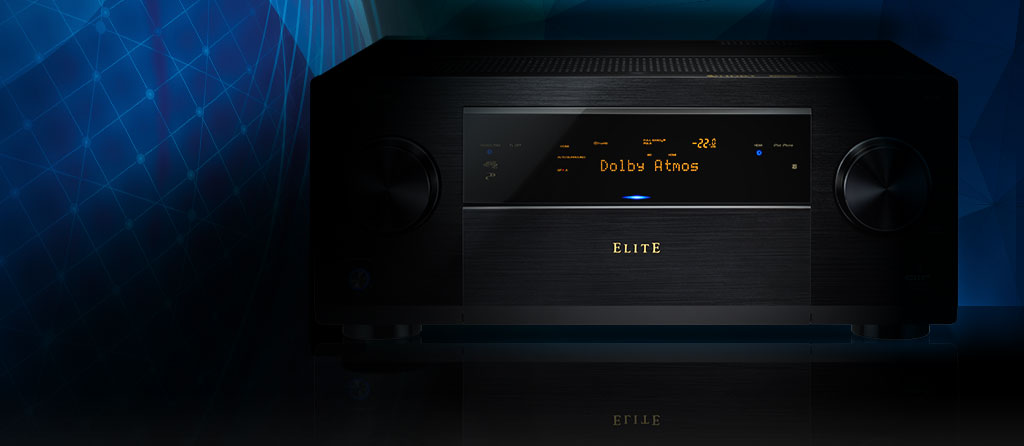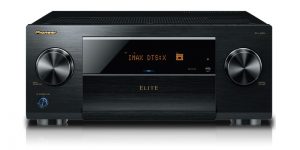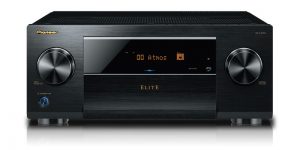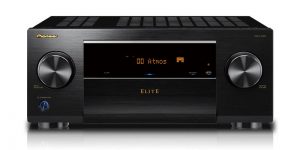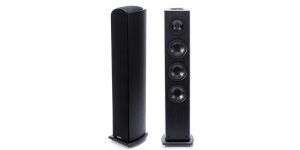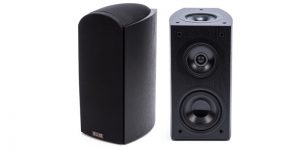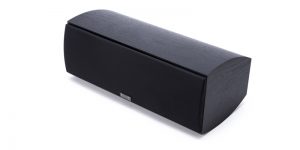JUST WHAT IS
DOLBY ATMOS?
Immerse yourself in the best of home cinema with a three dimensional sound experience that only Pioneer Elite with Dolby Atmos can deliver.
Working in unison with your favorite Atmos-enabled content, Pioneer Elite plunges you directly into the movie scene with unprecedented localized sound. You experience a sense of motion, enveloping you in a three-dimensional space, expanding the sound field to new acoustic heights.
Further enhanced by Pioneer exclusive technologies, such as direct power input from Pioneer Class D3 amplification and Pioneer MCACC Pro calibration, only available for Pioneer Elite receivers.
Explore the depths of unprecedented acoustic quality with Pioneer Elite and Dolby Atmos.
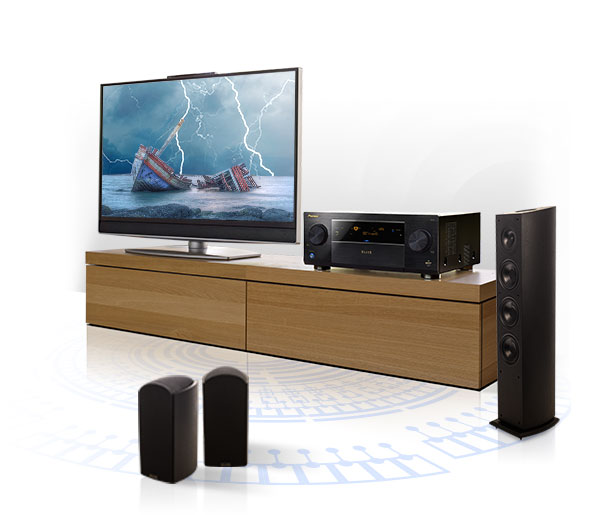
CREATING DYNAMIC SOUND
IN THREE DIMENSIONS
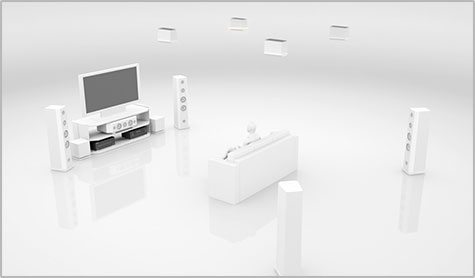
It’s not every day that an innovative multi-dimensional audio experience comes along, and these revolutionary experiences demand evolutionary engineers.
Andrew Jones, Pioneer’s groundbreaking chief audio engineer, designed a world-class speaker system worthy of the Elite brand. Laboriously extracting each detail and note, producing the same sound quality exactly as Dolby Atmos engineers expect.
Configuration is simple—mount top speakers on your ceiling, or our Elite elevation driven home theater speakers into an existing floor-based array, It’s your choice.
Combined with a Pioneer Elite Atmos -compatible receiver with Class D3 amplification our new MCACC Pro calibration, our Elite Speakers adapt and tune to your audio space’s configuration for a powerful, balanced output.
Only Pioneer Elite gives you the customization so you can tune your listening environment for the absolute best reproduction of the
Dolby Atmos experience.

HOW TO BRING IT
ALL TOGETHER
The new realm of multi-dimensional sound begins with a Dolby Atmos compatible Pioneer Elite receiver combined with:
- Sound space with an 8’-14’, flat,
acoustically reflective ceiling - Pioneer Elite Dolby-Enabled Bookshelf or Floorstand Speakers
- Blu-ray player
- Blu-ray Disc content encoded
for Dolby Atmos
Pioneer Elite receivers deliver the critical multi-channel processing and necessary power required to fully create the Dolby Atmos effects.
Along with the new line of Andrew Jones designed Elite speakers, the Pioneer Elite system delivers exceptional sound quality that brings the technology to life.
Plus, using Pioneer MCACC-Pro you precisely tune your sound space to automatically correct phase—as well as distance, level and tone—achieving precise direct speaker drive based on your space.
Use an existing 5.2 (or higher) floor-based system and expand to a 5.2.4 three-dimensional array with Pioneer Elite and the Pioneer Dolby-Enabled Elevation-Driven speakers.
For sound spaces without ceiling-mounted speakers, our Pioneer Elite Bookshelf and Floorstand Speakers direct sound towards the ceiling to achieve the same results and effects through the resulting reflected sound.
Carve out your own sphere of three-dimensional sound in your home theater now. Come hear for yourself the totally immersive experience of Pioneer Elite receivers with Dolby Atmos technology.
PIONEER AND ELITE
COMPATIBLE RECEIVERS
ELITE
SPEAKERS
FREQUENTLY ASKED QUESTIONS
- WHAT IS THE DIFFERENCE BETWEEN DOLBY ATMOS IN THE CINEMA AND DOLBY ATMOS IN THE HOME?
The cinema, with its giant screen and massive sound system, will always be the reference for the ultimate entertainment experience. While home theaters have fewer speakers, the Dolby Atmos home experience is extremely powerful. It combines traditional home theater speaker layouts with many new possible speaker positions, including either ceiling-mounted speakers or new Dolby Atmos enabled speakers that reproduce sounds coming from above you. The impact of either in-ceiling or Dolby Atmos enabled speakers is breathtaking; your room fills with realistic, multidimensional sound that places you directly in the center of the entertainment experience. - HOW DOES DOLBY ATMOS CINEMA CONTENT TRANSITION TO HOME THEATERS?The Dolby Atmos experience in the cinema is so powerful and flexible because of its revolutionary use of audio objects. To deliver the full object-based soundtrack to home theaters, Dolby developed new home authoring tools and new encoding methods that take into account the spatial information of the sound objects to efficiently encode them in Dolby® TrueHD and Dolby Digital Plus™. This spatial coding is not a channel-based, matrix-encoding system like Dolby Pro Logic® II or Dolby Pro Logic IIz. Instead, this fundamentally new coding technique allows all the audio objects created for the cinema to be used in the home theater. Nothing is lost.Initially, home theaters will be able to play Dolby Atmos content on Blu-ray™ discs or through streaming video services. No matter the source, when a Dolby Atmos stream is fed to a Dolby Atmos compatible A/V receiver, the receiver will render the object-based audio to your home theater’s unique speaker configuration to precisely recreate the sound the filmmakers intended. Because the object-based audio mix is delivered to home theaters, Dolby Atmos has the ability to adapt to extremely diverse speaker setups, from systems with five speakers on the floor and two speakers producing overhead sound to Dolby Atmos supersystems with 24 speakers on the floor and 10 overhead speakers.
- WHO IS CREATING CONTENT, SUCH AS MOVIES, FOR DOLBY ATMOS IN THE HOME?Globally, more than 100 cinema blockbusters have been released featuring Dolby Atmos soundtracks since 2012, and many more are on the way. Major Hollywood studios are partnering with Dolby to create home video versions of current box office releases—and previously released favorites—for release in 2014. In addition to global studio partnerships, Dolby is partnering with game and music content creators to take advantage of Dolby Atmos technology for future home theater use.
- WHAT HOME SETUP DO I NEED TO EXPERIENCE DOLBY ATMOS?
To experience this sound revolution, you’ll need a way to play or stream Dolby Atmos content, and to create your own Dolby Atmos home theater environment.Options to Play or Stream Content1. You can play Dolby Atmos content from a Blu-ray Disc™ through an existing Blu-ray Disc player. Be sure you have a player that’s fully compliant with Blu-ray specifications.*Or2. You can stream content from a compatible game console, Blu-ray, or streaming media player. In both cases, be sure to set your player to bitstream output.** Note that Dolby Atmos is compatible with the current HDMI® specification (v1.4 and later).You then have several options for configuring your home playback system.You’ll be able to assemble your own system from a wide range of available A/V components, starting with an A/V receiver (AVR) or pre-processor that supports Dolby Atmos. Many leading AVR manufacturers are introducing products in 2014 that support Dolby Atmos for the home. Several companies will offer complete home-theater-in-a-box solutions that support Dolby Atmos. These systems offer you the benefits of extraordinary Dolby Atmos sound together with the convenience and simplicity of an all-in-one system.Watch for announcements throughout the year.* You will not need to replace your Blu-ray player as long as it fully conforms to the Blu-ray specification. Current generation Blu-ray players, and most older players, are compatible. You should check with the Blu-ray player manufacturer if you encounter problems. Some Blu-ray players default to secondary audio, a playback mode where third party content is mixed with the primary soundtrack and output as a Dolby Digital signal. Be sure to turn this feature off to insure decoding and playback of Dolby Atmos content by your AVR.** Decoding and rendering of Dolby Atmos content is managed entirely by the A/V receiver. To properly pass the Dolby Atmos audio to the AVR, source devices must be connected to the AVR via HDMI and set to audio bitstream out. - I ALREADY HAVE A HOME THEATER. DO I HAVE TO REPLACE ALL OF MY CURRENT SPEAKERS TO BUILD A DOLBY ATMOS SYSTEM?
No.Many people now have 5.1 or 7.1 systems with a subwoofer and either five or seven speakers positioned at or about at ear level. Many of these speakers will work without a problem in a Dolby Atmos system.However, overhead sound is a vital part of the Dolby Atmos experience. Many current home theaters aren’t capable of producing overhead sound, but there are a number of options for adding this capability to any room. - HOW CAN I GET OVERHEAD SOUND IF I DON’T MOUNT SPEAKERS IN MY CEILING?Use speakers equipped with Dolby Atmos enabled technology.Through our knowledge of psychoacoustics and sound physics, we’ve developed speakers that can create overhead sound even though they’re only a few feet off the floor. These speakers fire sound upward, where it reflects off the ceiling to produce an incredibly lifelike recreation of overhead sound—you really have to hear them to believe them.You will be able buy integrated Dolby Atmos enabled speakers that include both traditional forward-firing speakers and upward-firing speakers in one speaker cabinet. (Those speakers have two sets of posts, one for the traditional speaker and one for the upward-firing Dolby Atmos enabled speaker.)But if you already have conventional speakers you like, you can simply buy Dolby Atmos enabled add-on speaker modules. These include only the upward-firing speakers. You can put the add-on modules on top of your current speakers or on another nearby surface.
- WILL DOLBY ATMOS ENABLED SPEAKERS WORK IN MY ROOM?
Dolby Atmos enabled speakers can produce an incredibly accurate Dolby Atmos experience in many kinds of rooms. You’ll get the best sound if your ceiling is flat (not vaulted or angled) and made of an acoustically reflective material, such as drywall, plaster, concrete, or wood.While we designed the technology for rooms with ceiling heights of 8 to 9 feet (2.4 to 2.7 meters), our testing indicates that you can still hear incredible Dolby Atmos sound in rooms with ceilings as high as 14 feet (4.3 meters), though the effect may become more diffuse in rooms with higher ceilings.Recessed lighting fixtures, chandeliers, crown molding, and heating or air conditioning vents in your ceiling do not noticeably interfere with the Dolby Atmos experience. - WHAT IS THE SMALLEST SETUP THAT DOLBY RECOMMENDS? WHAT IS THE LARGEST?
Because audio that originates from overhead is a key contributor to the Dolby Atmos experience, Dolby recommends using at least two speakers to generate overhead audio elements. This gives the minimal ability to move audio from left to right above the listener. The addition of four or more speakers to generate overhead audio elements provides the ability to move audio left to right and front to back above the listener. This provides greater precision to the Dolby Atmos experience.For high-end home theaters, a 7.1.4 system (a traditional 7.1-channel-based layout with four overhead or Dolby Atmos enabled speakers) will provide a great listening experience. That being said, Dolby Atmos can support home theater systems with up to 34 speakers, in a 24.1.10 configuration: 24 speakers on the floor and 10 overhead speakers.However, Dolby Atmos content is not tied to any specific playback configuration. Whether you have a full 7.1.4 system or a 5.1.2 system, your receiver will get the same content and play it back in a way that takes full advantage of your specific setup. - IF DOLBY ATMOS ALLOWS ME TO ADD MORE SPEAKERS, WHY DO I SEE A/V RECEIVERS WITH JUST 11 CHANNELS?
Many hardware partners are building or planning to build Dolby Atmos enabled A/V receivers and speakers. Those partners decide what product configurations make the most sense for their customers. But Dolby Atmos for the home is almost unlimited. One of our hardware partners is planning to release an A/V receiver with 32 channels. - IF THIS IS NOT A CHANNEL-BASED SYSTEM, WHY ARE THERE PREDEFINED SPEAKER POSITIONS?
While the Dolby Atmos algorithm is capable of rendering audio to virtually any speaker position, we defined 34 designated positions for speakers on the floor and overhead to simplify the setup process. By using these predefined positions, you can more easily configure your system.We also defined a few “reference” speaker configurations to ensure that early customers could have a great experience while having the option to keep most of the equipment they already have. Among those reference setups are the 5.1.2 configuration, which involves adding two ceiling or Dolby Atmos enabled speakers to a traditional 5.1 system, and the 7.1.4 configuration, which starts with a traditional 7.1 system and adds four ceiling or Dolby Atmos enabled speakers. These configurations also ensure that you can play content mixed in legacy channelbased audio.But we believe this is just the beginning. Because the Dolby Atmos object-based audio system is so adaptable, you can use many other speaker configurations. No matter what system you build, the Dolby Atmos format and system will adapt itself to output the best audio experience possible. - HOW WILL I GET DOLBY ATMOS MOVIES?
We wanted to ensure that entertainment fans could get Dolby Atmos movies in the same ways they get movies now, on Blu-ray Disc or through streaming video services.We invented new scalable algorithms and extensions to Dolby TrueHD, our Blu-ray format, and Dolby Digital Plus, which is used by leading streaming video providers. Both formats now support Dolby Atmos sound, meaning that you’ll be able to play Dolby Atmos movies from your Blu-ray player or through your digital media adapter. - SHOULD I BUY DOLBY ATMOS CONTENT EVEN IF I DON’T HAVE NEW EQUIPMENT?The Dolby Atmos format was designed to be backward compatible, so it will play on both new and existing hardware platforms. We recommend you purchase the Dolby Atmos version of content whenever that is available. In the future, upgrading your equipment to Dolby Atmos capable products will unlock the ultimate experience from Dolby Atmos content. In the meantime, you will get a great surround experience from traditional channel-based systems.
- WHAT IF I BUILD A DOLBY ATMOS SYSTEM BUT WANT TO PLAY CONTENT THAT ISN’T IN DOLBY ATMOS?A Dolby Atmos home theater can play any stereo, 5.1, or 7.1 content. Using the Dolby surround upmixer function in Dolby Atmos enabled AVRs, you can choose to have our technology automatically adapt that channel-based signal to use the full capabilities of your new system, including your overhead speakers, ensuring that you hear realistic and immersive sound.
